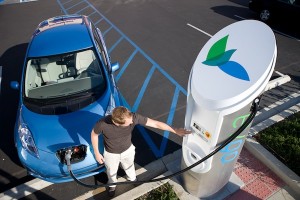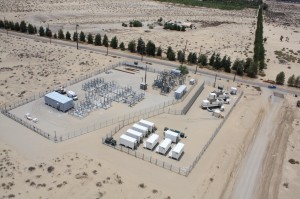SDG&E employed the Borrego Springs Microgrid because the transmission line that usually feeds the community had been damaged by lightning. SDG&E crews needed to replace or repair three transmission poles, which would usually require a 10-hour sustained outage to the entire community of Borrego Springs. However, SDG&E was able to call on the Borrego Springs Microgrid to avoid the impact of a major outage. The Borrego Springs Microgrid uses advanced technologies – including local power generation, energy storage, and automated switching – to create a more resilient local grid for the benefit of customers. The Microgrid is connected to the centralized energy grid, but can disconnect from the larger grid and function independently during emergencies, supplying vital electricity to the local community through its onsite resources.
UCSD’s microgrid performed a similar function back in 2011, helping to avert a worse power outage for San Diego. But this Borrego Springs example is unique.
Microgrids will increasingly become a critical resilience strategy as climate change unleashes more extreme weather, plus more dependence on intermittent renewables.
As they say, the future is already here, just not widely distributed yet.
Back in 2011, California regulators banned the state’s electric utilities from owning and operating electric vehicle charging equipment. Part of the logic was that utilities would crowd out innovation, using their monopoly power and capital resources to dominate the market.
 But so far, electric vehicle charging infrastructure in the state is rolling out poorly. eVgo, the company that received a $100 million state mandate to deploy charging infrastructure, is way behind schedule. Many existing charging stations are crowded and too few and far between, while the equipment is unreliable and often unavailable when you need it. Meanwhile, competing charging companies have developed cumbersome “networks” that you have to sign up for in order to access their chargers, instead of just having a simple, universal payment method like a gas station credit card reader.
But so far, electric vehicle charging infrastructure in the state is rolling out poorly. eVgo, the company that received a $100 million state mandate to deploy charging infrastructure, is way behind schedule. Many existing charging stations are crowded and too few and far between, while the equipment is unreliable and often unavailable when you need it. Meanwhile, competing charging companies have developed cumbersome “networks” that you have to sign up for in order to access their chargers, instead of just having a simple, universal payment method like a gas station credit card reader.
So is it time to call in the cavalry (i.e. utilities) to flood the market with cheap charging? San Diego Gas & Electric would certainly like to get that call. The company recently proposed a “pilot project” that looks more like a large-scale EV charging effort:
The [vehicle-grid integration] pilot is an “innovative hourly time-variant rate and associated grid-beneficial charging infrastructure,” SDG&E said, calling for authorization to develop 5,500 charging stations targeting multi-family dwellings and workplaces between 2015 and 2025. The VGI pilot would require approximately $59 million in capital costs and $44 million in operations and maintenance over the life of the project.
The California Public Utilities Commission has punted consideration of this pilot to the larger proceeding dealing with the question of electric utility involvement in charging more generally. That proceeding may issue a ruling in December.
From my perspective, the current charging infrastructure is inadequate and frustrating. Limited involvement by utilities might be welcome, provided that it’s done on a small scale to make sure we don’t unleash a beast. Perhaps the SDG&E pilot, or a smaller version of it, could be a good first step. The ultimate resolution of these issues will of course depend on careful fact-finding at the proceeding and input from stakeholders. But the bottom-line focus should be on the provision of cheap, reliable, ubiquitous, and easy-to-use charging for EV drivers.



